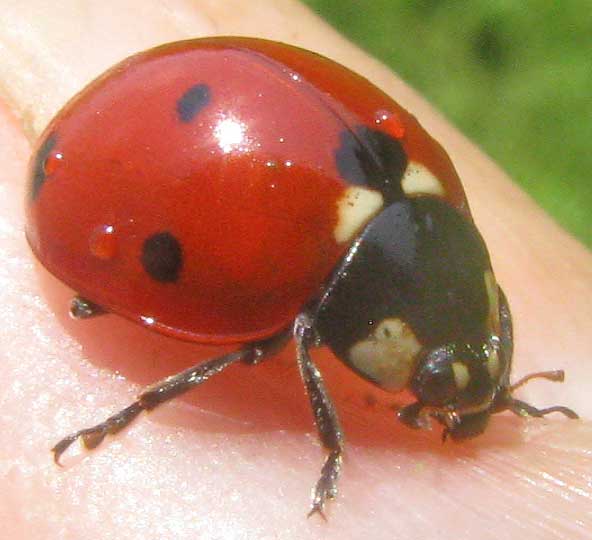Excerpts from Jim Conrad's
Naturalist Newsletter

from the August 19, 2012 Newsletter issued from the woods of the Loess Hill Region a few miles east of Natchez, Mississippi, USA
SEVEN-SPOTTED LADYBUG
On a head-high Sesbania beside a flooded wildlife field in St. Catherine Creek National Wildlife Refuge just south of Natchez a bright red ladybug caught Karen's eye, and she pointed it out to me. That it above.
I'm always glad to see ladybugs because they are such important insects, voraciously preying on aphids and other plant-damaging invertebrates, plus ladybug numbers have plummeted, as made clear at the LostLadybug.Org website at http://www.lostladybug.org/.
I'm also glad to find ladybugs because on the Internet there's a wonderful, free, well illustrated, interactive identification key, at https://www.discoverlife.org/20/q?guide=Ladybug.
With that fun-to-use key I figured out that our Sesbania-perched ladybug was the Seven-spotted Ladybug, COCCINELLA SEPTEMPUNCTATA, an alien species introduced into the US from Europe in 1956. In Europe Seven-spotteds are the most common ladybug species. One reason it's become so widespread in the US is that it's been repeatedly introduced here as a biological control agent to reduce aphid numbers. It's such a handsome, beneficial species that despite being an invasive it's been designated the official state insect of six different states -- Delaware, Massachusetts, New Hampshire, Ohio, Pennsylvania, and Tennessee.
The ladybugs' bright colors warn birds and other predators that ladybugs are bad to eat. Seven-spotted Ladybugs secrete toxic alkaloids -- N-oxide coccinelline and its free base precoccinelline -- from joints in their legs.
You might consider getting involved in the Lost Ladybug Project, designed to monitor the welfare of the various ladybug species, and particularly welcoming for younger participants. Despite my age, I thought the Project folks might appreciate my fairly decent picture documenting the species in a part of the country less studied than many others so I went to the Lost Ladybug site at http://www.lostladybug.org/, clicked on "upload photos," provided collection information such as exact latitude and longitude, and uploaded my picture. I was surprised a few days later when an email informed me that the ID had been confirmed, and that my information had been added to the Lost Ladybug databank.
Our Seven-spotted Ladybug turns out to be very frequently documented all across the continent, including by several other spotters in Mississippi, so my observation is not a big deal. However, now I'm so sensitized to ladybugs and well informed about them that henceforward I intend to make special efforts to look for them, and continue contributing to the Lost Ladybug Project's database.